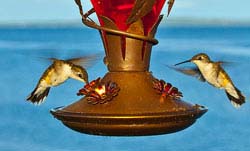Sage Words About Wildlife: Birdbath and Hummingbird Feeder Care

Sometimes it is difficult for hummingbirds to get all the nectar they need from the garden, even if you have a number of Salvias. Hummingbird feeders are good for supplementing mother nature and attracting a larger crowd of the Family Trochilidae.
Another attraction that pleases hummingbirds is a water feature such as a mister or bubbler attached to a birdbath, because it is difficult for them to bath in a pool of water.
Selecting Feeders
The best kinds of feeders are the ones that are easiest to take apart for cleaning. Some avid hummingbird fans swear by the kind that look like clear, shallow bowls with removable, red plastic lids in which flower-shaped ports allow access to narrow hummingbird beaks.
Don't get the kind that accentuate these ports with yellow plastic flowers, because yellow is a favorite color for attracting bees and wasps. Do get one that has a railing or perch rods on which hummers can sit while dining. It helps them to conserve energy.
It's important to keep hummingbird feeders and water features clean to prevent disease that can harm them.
Healthy Feeder Practices
Hanging feeders in shady areas causes the sugar water to ferment less rapidly. However, if you hang them in sunny areas it may be easier for hummers to find them. In that case, just clean them more frequently. Also, never give hummers honey or plant nectar in their water, because these ferment quickly.
Forget about adding red food coloring to the solution, because experts say it isn't good for the birds. Audubon provides a recipe for making hummingbird nectar and stresses that "plain white table sugar" is the safest sweetener to add.
After about two days, or sooner if the feeder solution becomes cloudy or you see any mold, drain the solution and scrub the feeder with hot water.
Different hummingbird websites vary in their instructions about soap and cleansers. However, many say not to use them, because -- aside from hummers not liking the flavor -- traces of these materials might make them ill.
When there is mold in a tube feeder, fill it with hot water and scrub with a bottlebrush. If necessary, add some fine gravel or rice to the water-filled tube, then shake it to loosen the mold. Rinse the feeder a few times. The same directions go for a dish feeder, but you likely won't need corrosive materials to remove mold.
A Quick Word About Birdbath Cleanliness
Hummingbirds rarely take a dip in birdbaths, because their tiny feet make it difficult to walk. However, they love misters, bubblers and tiny fountains attached to birdbaths. They hover amid the spray or perch when possible where gentle splashing action is available.
For the health of all birds visiting a birdbath, keep the water fresh and clean by removing plant debris and rinsing it out every few days with a garden hose. If it needs more cleaning, scrub it with a stiff brush and then rinse.
One last winged thought: Place a water feature in a location near but not in shrubbery. All birds appreciate access to foliage, but need to be able to see if predators are approaching.

Comments
There are no comments yet.